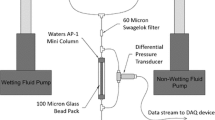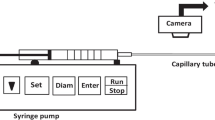Abstract
This paper reports the results of extensive experimental studies of the effects of well-defined heterogeneous porous media on immiscible flooding. The heterogeneities were layers and lenses, with some of the lenses being a wettability contrast. Drainage and imbibition displacements, with and without an initial residual fluid saturation, were carried out at a variety of flow rates on layered and lensed two-dimensional glass beads models of the size of a typical large core test (58×10×0.6 cm). These displacements were followed photographically and the effluent saturation profiles recorded. In most of the experiments the glass beads were water-wet, but in some the lens beads were coated with a water repellent chemical. In all experiments, the displacement fronts became highly irregular due to the different capillary pressures acting in the different areas of the models. In this paper, these displacements are fully reported and their implications for reservoir simulation and for interpretation of laboratory core tests, where the inner heterogeneities are not known, are discussed.
Similar content being viewed by others
References
Archer, J. S. and Wong, S. W., 1973, Use of a reservoir simulator to interpret laboratory waterflood data,Soc. Pet. Eng. J. 13, 343–347.
Bentsen, R. G. and Saeedi, J., 1981, Liquid—liquid immiscible displacement in unconsolidated porous media,J. Can. Petrol. Technol.,20(1), 93–103.
Clifford, P. J., 1988, Simulation of small chemical slug behaviour in heterogeneous reservoirs, SPE/DOE Enhanced Oil Recovery Symposium, Paper 17399, April 1988, pp. 873–885.
Dawe, R. A., 1979 The obtaining of oil from an oil reservoir — part 2, experimental,School Science Review 61, 111–118
—, 1983 The obtaining of oil from an oil reservoir — part 4, Model studies of displacements in reservoirs,School Science Review 64, 746–52.
Grattoni, A. G. and Bidner, M. S., 1990, History matching of unsteady state corefloods for determining capillary pressure and relative permeabilities, SPE Paper 21135. Society of Petroleum Engineers, presented at Latin American Petroleum Engineering Conference, Rio de Janeiro, Brazil, October 1990.
Hove, A. O., Nilsen, V. and Leknes, J., 1990, Visualisation of xanthan flood behaviour in core samples by means of x-ray tomography,SPE Reservoir Engng. 5, 475–480.
Huppler, J. D., 1970, Numerical investigation of the effects of core heterogeneities on waterflood relative permeabilities,Soc. Pet. Eng. J. 10, 381–392.
Jones, S. C. and Roszelle, W. O., 1978, Graphical techniques for determining relative permeability from displacement experiments,J. Petrol. Technol. 30, 807–817.
Lambeth, N. and Dawe, R. A., 1987, Viscous effects for miscible displacements in regular heterogeneous porous media,Chemical Engng Res. and Design 65, 52–62.
McKean, H. C. and Dawe, R. A., 1990, Numerical simulations of displacements containing a lens heterogeneity,J. Can. Petrol. Technol. 29(6), 88–93.
McMillan, D. J., 1987, Automatic history matching of laboratory corefloods to obtain relative-permeability curves,SPE Reservoir Engng 2(1), 85–91.
Parsons, R. W., 1975, Microwave attenuation — a new tool for monitoring saturations in laboratory flowing experiments,Soc. Pet. Eng. J. 15, 302–310.
Sigmund, P. M. and McCaffrey, F. G., 1979, An improved unsteady-state procedure for determining the relative-permeability characteristics of heterogeneous porous media,Soc. Pet. Eng. J. 19(1), 15–28.
Wheat, M. R., 1984, PhD Thesis, The Role of Heterogeneities in Oil Recovery, Imperial College, University of London.
Wright, R. J. and Dawe, R. A., 1983, Fluid displacement efficiency in layered porous media — mobility ratio influence,Revue de l'Institut FranÇais du Pétrole,38(2), 455–474.
Wright, R. J., Wheat, M. R. and Dawe, R. A., 1987, Slug size and mobility requirements for chemically enhanced oil recovery within heterogeneous reservoirs,SPE Reservoir Engng. 2(1), 92–102.
Yokoyama, Y. and Lake, L. W., 1981, The effects of capillary pressure on immiscible displacements in stratified porous media, 56th Annual Fall Conference, San Antonio, Texas. SPE paper 10109.
Author information
Authors and Affiliations
Rights and permissions
About this article
Cite this article
Dawe, R.A., Wheat, M.R. & Bidner, M.S. Experimental investigation of capillary pressure effects on immiscible displacement in lensed and layered porous media. Transp Porous Med 7, 83–101 (1992). https://doi.org/10.1007/BF00617318
Received:
Revised:
Issue Date:
DOI: https://doi.org/10.1007/BF00617318




